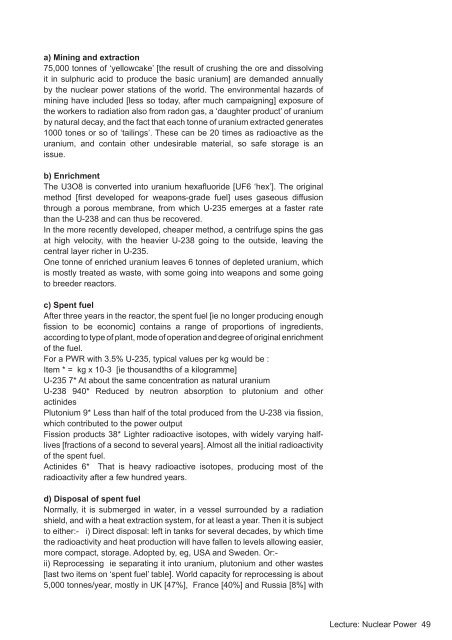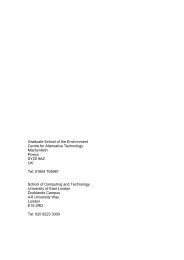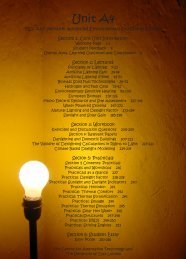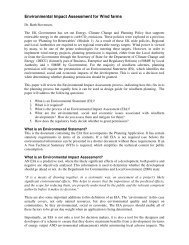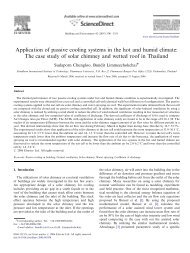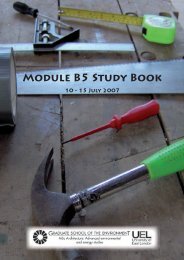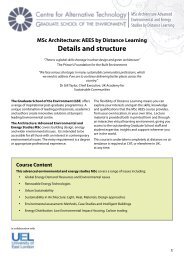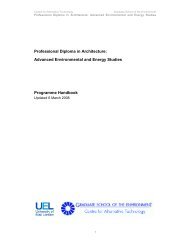Module B1 Study Book - the Graduate School of the Environment
Module B1 Study Book - the Graduate School of the Environment
Module B1 Study Book - the Graduate School of the Environment
You also want an ePaper? Increase the reach of your titles
YUMPU automatically turns print PDFs into web optimized ePapers that Google loves.
a) Mining and extraction<br />
75,000 tonnes <strong>of</strong> ‘yellowcake’ [<strong>the</strong> result <strong>of</strong> crushing <strong>the</strong> ore and dissolving<br />
it in sulphuric acid to produce <strong>the</strong> basic uranium] are demanded annually<br />
by <strong>the</strong> nuclear power stations <strong>of</strong> <strong>the</strong> world. The environmental hazards <strong>of</strong><br />
mining have included [less so today, after much campaigning] exposure <strong>of</strong><br />
<strong>the</strong> workers to radiation also from radon gas, a ‘daughter product’ <strong>of</strong> uranium<br />
by natural decay, and <strong>the</strong> fact that each tonne <strong>of</strong> uranium extracted generates<br />
1000 tones or so <strong>of</strong> ‘tailings’. These can be 20 times as radioactive as <strong>the</strong><br />
uranium, and contain o<strong>the</strong>r undesirable material, so safe storage is an<br />
issue.<br />
b) Enrichment<br />
The U3O8 is converted into uranium hexafluoride [UF6 ‘hex’]. The original<br />
method [first developed for weapons-grade fuel] uses gaseous diffusion<br />
through a porous membrane, from which U-235 emerges at a faster rate<br />
than <strong>the</strong> U-238 and can thus be recovered.<br />
In <strong>the</strong> more recently developed, cheaper method, a centrifuge spins <strong>the</strong> gas<br />
at high velocity, with <strong>the</strong> heavier U-238 going to <strong>the</strong> outside, leaving <strong>the</strong><br />
central layer richer in U-235.<br />
One tonne <strong>of</strong> enriched uranium leaves 6 tonnes <strong>of</strong> depleted uranium, which<br />
is mostly treated as waste, with some going into weapons and some going<br />
to breeder reactors.<br />
c) Spent fuel<br />
After three years in <strong>the</strong> reactor, <strong>the</strong> spent fuel [ie no longer producing enough<br />
fission to be economic] contains a range <strong>of</strong> proportions <strong>of</strong> ingredients,<br />
according to type <strong>of</strong> plant, mode <strong>of</strong> operation and degree <strong>of</strong> original enrichment<br />
<strong>of</strong> <strong>the</strong> fuel.<br />
For a PWR with 3.5% U-235, typical values per kg would be :<br />
Item * = kg x 10-3 [ie thousandths <strong>of</strong> a kilogramme]<br />
U-235 7* At about <strong>the</strong> same concentration as natural uranium<br />
U-238 940* Reduced by neutron absorption to plutonium and o<strong>the</strong>r<br />
actinides<br />
Plutonium 9* Less than half <strong>of</strong> <strong>the</strong> total produced from <strong>the</strong> U-238 via fission,<br />
which contributed to <strong>the</strong> power output<br />
Fission products 38* Lighter radioactive isotopes, with widely varying halflives<br />
[fractions <strong>of</strong> a second to several years]. Almost all <strong>the</strong> initial radioactivity<br />
<strong>of</strong> <strong>the</strong> spent fuel.<br />
Actinides 6* That is heavy radioactive isotopes, producing most <strong>of</strong> <strong>the</strong><br />
radioactivity after a few hundred years.<br />
d) Disposal <strong>of</strong> spent fuel<br />
Normally, it is submerged in water, in a vessel surrounded by a radiation<br />
shield, and with a heat extraction system, for at least a year. Then it is subject<br />
to ei<strong>the</strong>r:- i) Direct disposal: left in tanks for several decades, by which time<br />
<strong>the</strong> radioactivity and heat production will have fallen to levels allowing easier,<br />
more compact, storage. Adopted by, eg, USA and Sweden. Or:-<br />
ii) Reprocessing ie separating it into uranium, plutonium and o<strong>the</strong>r wastes<br />
[last two items on ‘spent fuel’ table]. World capacity for reprocessing is about<br />
5,000 tonnes/year, mostly in UK [47%], France [40%] and Russia [8%] with<br />
Lecture: Nuclear Power 49


